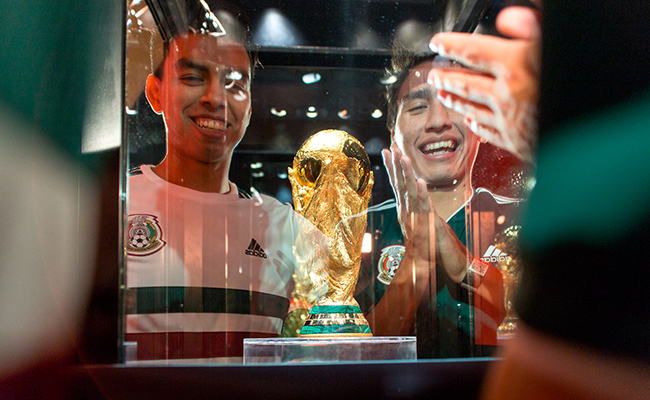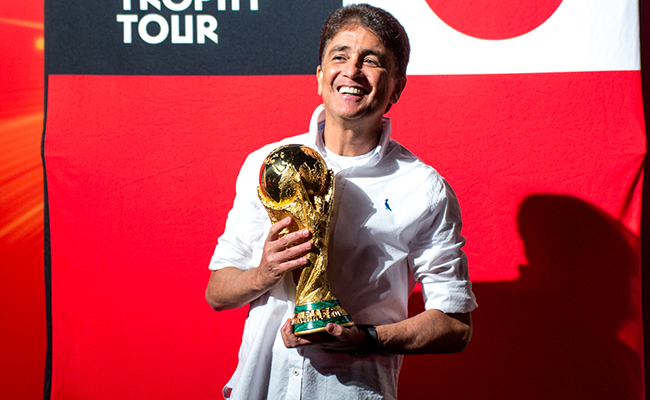
LOS ANGELES — The World Cup trophy has a modesty drape.
That’s not all it has. The trophy also has an entourage, a security detail, and a private jet. FIFA and Coca-Cola have been on the road since September of last year, bringing the World Cup trophy to 51 countries on six continents, taking it literally around the world so football (or soccer, if you insist) fans and VIPs can get a glimpse of it up close and personal. The trophy had never before been on the soil of 25 of the countries that this Tour visited, and the Tour-branded private jet is continuing its globe-hopping as we speak.
I traveled with the trophy for several days (continually resisting the urge to refer to it as “The Cup,” although I occasionally slipped up), and got to see business partners, influencers, fans, and a former player interact with it. Well, with one exception, maybe “interact with” is a misleading term. The trophy — which is over a foot tall and which I’m told weighs over 13 pounds and is made of 18-carat gold and malachite — is only allowed to be touched directly by heads of state, or by players who have actually won the World Cup in the past.
Hence the modesty drape.
The trophy is transported in secret, even among those traveling on the plane with it. When the team gets to a location where the trophy will be displayed, the drape goes up, and like a magic trick, when it descends, the trophy is in place, behind glass, on a pedestal. While I was with the trophy, I got to see a handful of partner events in New York and Miami where the trophy would be unveiled — including at Twitter HQ in Manhattan and at the brand-new Telemundo studio in Florida — and every time, the unveiling resulted in breathless wonder and applause from those assembled.
Even people who don’t follow football closely wanted to get their picture with the trophy, because everyone knows the World Cup is special. And as such, the most important and special stops on the World Cup Trophy Tour were the fan events. Most of the countries where the tour stopped featured fan events, and our leg of the tour — Mexico City to New York to Miami to Los Angeles — began and culminated in fan events. L.A. Live hosted the trophy for two days, where thousands of fans were able to stop by, look at, and get a picture with the trophy, rotating in a lighted case that made it look like something the Avengers might have to punch someone for.
In Mexico City and Los Angeles, the fan events were attended by former World Cup winners. A spokesperson for the tour told me that “over 70 percent” of the fan events have featured a former winner. In Los Angeles, Brazilian legend Bebeto stopped by the event to hoist the trophy, kiss it, and rock it like a little baby. After spending the better part of a week following the trophy from stop to stop, and to see so many people gaze at it through glass, it’s striking to see someone actually get to hold it in their hands. The assembled media stared in hushed awe as Bebeto cradled the trophy in his arms, getting emotional being near the same trophy Brazil won in 1994 at the Rose Bowl in Pasadena.

Bebeto is like all previous winners of the Cup, and all those striving to reach the pinnacle of the sport for their home countries, in that the importance and the weight that the trophy carries still resonates.
“You have no idea, the emotion to be next to this Cup [trophy],” Bebeto says through a translator. “When I was a child, I had the thought of one day raising this trophy. To be next to it, it’s an indescribable feeling, it’s a very strong feeling. All the sacrifice we went through, for one day to be able to raise it — if I had to make the same sacrifice, I would do it again. To be away from my family, my wife was pregnant at the time, for me, it was worth it. When we got to Brazil, when I really held the trophy when we were there. It was very cool, and I thank God so much for that.”
Perhaps key in the Trophy Tour is that all of the fan events and stops along the way are free to attend, something that FIFA and Coca-Cola insist upon in what is now their fourth such global Tour. Bebeto believes it’s important that fans get the opportunity to be so close to the trophy, the symbol of the ultimate achievement for footballers around the world.
That’s what the Tour presenters are adamant about as well. They began in Russia before moving on to Sri Lanka and the rest of the world. Things will come full circle when the Tour ends in Russia, as the country prepares to host the World Cup in June. Victoria Lopyreva, FIFA ambassador and former Miss Russia, has personally seen how taking the trophy on tour has affected fans in the host country.
“We already started the Trophy Tour inside Russia, and you can’t imagine how the Trophy Tour is really warming up the interest in the World Cup,” Lopyreva says. “It’s very important, because unfortunately, not everyone can come and be in person for the World Cup, but to visit the trophy, when there is a trophy is in your hometown somewhere — maybe in Mongolia — this is amazing. This is an amazing experience, and people are really happy to have the trophy in their cities.”
Jan Schetters, who is the Global Sponsorships Manager for the Coca-Cola Company and who previously worked for FIFA, assures me that although planning hasn’t officially begun, there was a Women’s World Cup Trophy Tour in 2015. The hope is that there will be another one next year as the United States Women’s National Team makes their push into France for the 2019 Women’s World Cup. Schetters has set foot in “46 or 47” of the 51 countries visited on the Trophy Tour, and believes that getting the trophy in front of the fans is the most important part and driving force of the Tour itself.
“There’s been a lot of excitement in every country we’ve been to,” says Schetters, who talked about the thrilled fans in far-flung areas like the Faroe Islands and Tonga, and has told stories throughout the Tour of football fans moved to tears at being inches away from the trophy that signifies the pinnacle of the sport. The insistence of the events being free is a welcome inclusionary gesture from a sport and a governing body that’s experienced a history of criticism about its elitism.
“For me, it’s a given [that it’s free],” Schetters says. “Everybody should have access to [the trophy]. If you put a price on it, then you select who is able to come or not. That’s not what we want to do to the fans. We want to get the football fans around the world ready for the FIFA World Cup. If we were to say, ‘You can only come if you pay 20 bucks, or 50 bucks,’ we’re not getting all of the fans ready for the World Cup. We want to get as many people as possible, and it should be absolutely free.”
While U.S. fans may have missed the chance to see the trophy while it was here, fans in Germany, Japan, and several other countries will have a chance before the World Cup kicks off in June. With any luck, we’ll get another Trophy Tour next year for the Women’s World Cup next year, and then it’ll just be three more years until the next one.
Despite not getting a chance to touch it, you can still feel the weight of the trophy’s history and the effect it still has on players like Bebeto. Thousands of children and players have looked at the trophy on its current tour and have dreamed about being able to hold it for themselves one day. Maybe one day, one of them will. And if not … hey, it’s still pretty cool to see it behind glass, just a few inches away, and know that it’s real.
Uproxx was invited on a hosted trip by Coca-Cola for the Trophy Tour.






